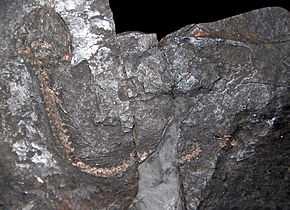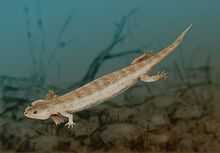Microbrachis
| Microbrachis Temporal range: Late Carboniferous, 307.1–302Ma | |
|---|---|
 | |
| Fossil of Microbrachis pelikani | |
| Scientific classification | |
| Kingdom: | Animalia |
| Phylum: | Chordata |
| Class: | "Amphibia" (wide sense) |
| Subclass: | †Lepospondyli |
| Order: | †"Microsauria" |
| Family: | †Microbrachidae Fritsch, 1883 |
| Genus: | †Microbrachis Fric, 1875 |
| Type species | |
| †Microbrachis pelikani Fric, 1875 | |
Microbrachis ('small arm') is an extinct genus of lepospondyl amphibian from the Carboniferous period of what is now the Czech Republic.

Life restoration of Microbrachis pelikani
Microbrachis was an elongated, salamander-like creature, about 15 centimetres (6 in) long, with over 40 vertebrae instead of the average 15-26 in its living relatives. It had minute limbs, and probably swam using fish-like lateral body movements. Microbrachis probably fed on fresh water plankton such as shrimp. Microbrachis was pedomorphic, retaining its larval gills in adulthood. Similar traits are found in the extant axolotl.[1]
References
- Andrew R. Milner, "The Tetrapod Assemblage from Nýrany, Czechoslovakia", in Systematics Association Special Volume No.15, "The Terrestrial Environment and the Origin of Land Vertebrates", ed. by A. L. Panchen, 1980, pp.439-496, Academic Press, London and New York
External links
| Wikispecies has information related to: Microbrachis |